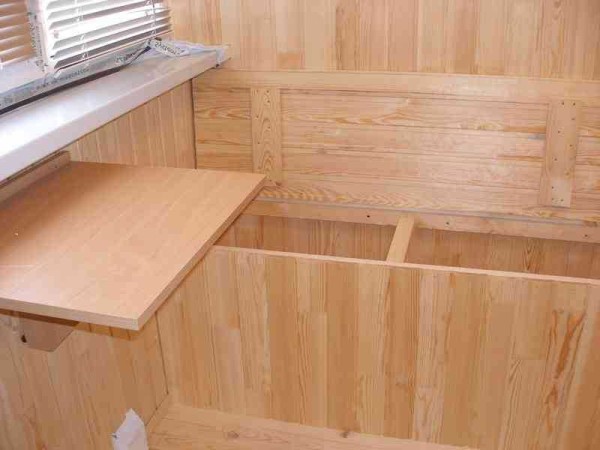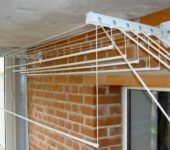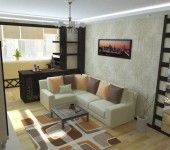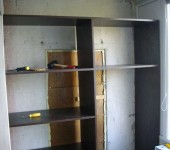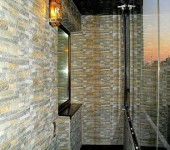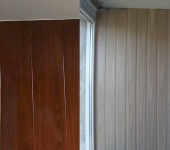Decorating the balcony with clapboard with your own hands
It is not so difficult to make a cozy place out of a balcony or loggia. Most often they decide to sheathe the balcony with clapboard. There is a lot of work, but it is not difficult and you can handle everything with your own hands.
The content of the article
Which lining to use
Basically, when they talk about lining, they mean wood products. Much less often this term is also called PVC panels, adding the word "plastic". Probably, the whole point is in the very similar principle of connecting the planks to each other and the method of their installation, and also in the fact that outwardly it looks like long boards with a spike on one side and a groove on the other. Choosing which lining to use for the balcony is usually based on cost, aesthetic or practical considerations.
In some regions, wooden lining is a cheap material, in some it is expensive. So you have to compare the price of plastic and wood yourself. Wood is often preferred because it is natural. This is true, but in order to maintain its attractiveness, it is impregnated with protective compounds, and this is chemistry. Then it is painted or varnished. The compositions, as you understand, are also far from natural.
If we proceed from practical considerations, then the PVC clapboard is definitely ahead: it is easy to clean, does not require additional maintenance or processing, and remains unchanged for many years. Unless on the sunny side, it will fade, so it is better to take light colors: on them, the loss of color is almost invisible.
Wooden lining is more capricious during operation: before installation, it must be covered with protective impregnations. If you are only going to give it a shade, you can choose such an impregnation that will immediately give you the desired color. Then its processing will end there. If you decide to paint or varnish the finish, then you need to do this after installation (but still soak with antiseptics before installation). During operation, it will periodically need to remove the old coating, and cover everything anew: the varnish or paint may crack, the balcony finish will lose its attractiveness. Here is such a hassle.
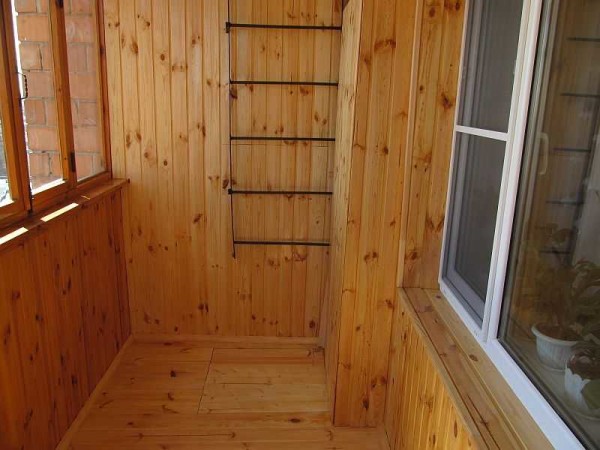
You decide which lining to choose for the balcony
Despite all this, deciding which lining is best for the balcony, they prefer wood. Tastes, of course, are different for everyone, but by all accounts, a room sheathed with wood is much more comfortable. As a result, the pursuit of beauty outweighs practical considerations.
How to cover the lining on the balcony so that it retains its attractiveness for a long time, read the article “How to cover the lining inside the premises»
Which is better
It's about wood products. Let's talk about breeds first. The cheapest lining is made of pine and spruce. Despite its relatively low cost, it is durable: coniferous wood contains a large amount of resins, which are antiseptics and preservatives. In regions with hot summers, this can lead to the fact that on the sunny side, in places of intense heating, tar will be released in places. Another disadvantage is soft wood. If you hit it (decently, for example, with a hammer), there will be a dent. If this does not scare you, you can sheathe the balcony with pine or spruce clapboard: these are all the disadvantages of this type of wood.

Only you can decide which lining is best for the balcony: everyone has different tastes
There are also expensive varieties of conifers: larch and cedar.They have a very denser wood, more durable, well resistant to weathering. But these qualities are absolutely unnecessary for covering the balcony inside. A more compelling argument is the beautiful color and texture of the wood, as well as less resin. Sheathing with clapboard made of such wood is beautiful and long-lasting.
Hardwoods are pleasing to the eye. Here, choose to your taste: linden has a slightly pinkish tint, aspen becomes silvery-gray, alder has a beautiful pattern, oak is out of competition in decorativeness and reliability, but also at a price too.
Profiles and appearance
Now about the technical characteristics. Let's start with profiles. On sale there is just a lining, but there is a Euro lining. The main difference is that there are one or more longitudinal grooves on the back of the Euro variant. They provide air circulation, which extends the life of the finish. Also, in theory, lumber with the prefix "euro" has standard sizes and should be produced from high quality wood. In practice, everything is different: both the dimensions "float" and the quality is not always good.

Most popular profiles
There are a couple of dozen profiles. Different chamfers, "waves" of different sizes and other curly surfaces allow you to get walls of different appearance. The photo above shows the most common, usually produced in large batches.
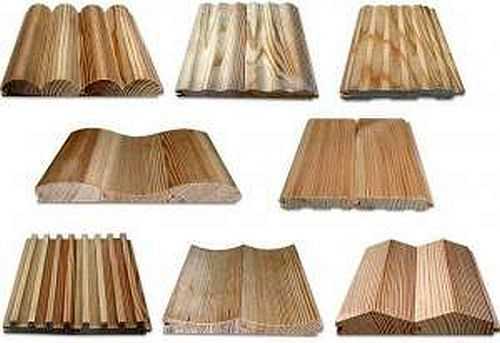
These are some types that can be made to order
There are several more types that can be made to order. Such a "custom-made" batch will cost significantly more: you will have to reconfigure the equipment.
Varieties and moisture
The grade of the lining depends on the number of knots, cracks and color changes that hit the board. Grade A or "Elite" should not have them at all, or in a very small amount. Grade "B" - no more than 4 brown knots and small color changes, grade "C" can have many knots.
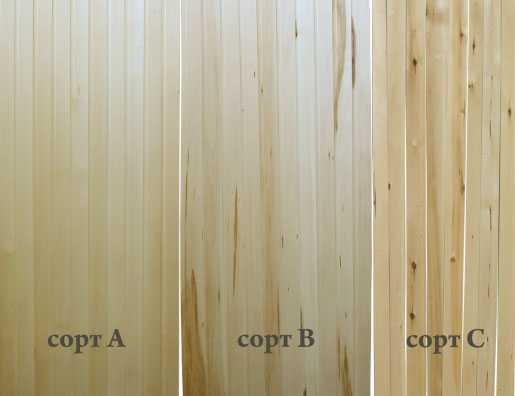
What is the difference between one grade of lining from another
The presence of knots does not mean that the wood is bad. The main thing is that they are brown, not black, and do not have traces of destruction. In general, knotty wood looks great at times. All this is a matter of taste and preference.
With humidity, the matter is much more serious. Buying raw wood lining for interior decoration can be much cheaper, but also much more troublesome. If you nail in trims with high moisture content, it will gradually dry out and decrease in size. There will be gaps between the boards, some of them will twist or bend. You will have to remove everything, sort it out and re-mount. Moreover, maybe twice: it is difficult to predict when the shrinkage will end. Therefore, for interior decoration of the balcony with clapboard, it is better to take kiln-dried lumber. Humidity is then not higher than 7-10%, it will not "drive" and will not bend: these materials were discarded after drying. Therefore, the prices are higher.
About the thickness and width of the slats. For interior decoration, you can take a thin board: the conditions of the atmosphere are stable. But the balcony is not quite an internal room, the temperature and humidity changes are more serious. Even with good insulation of the balcony. Therefore, the average thickness is suitable - 14-16 mm, but you can use 12 mm.
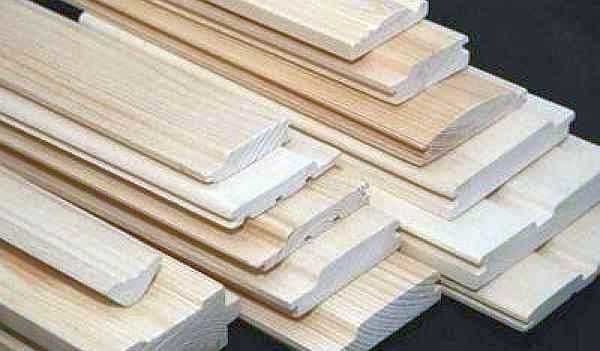
The width and thickness of the house varies widely
The width of the board can be from 60 mm to 150 mm. It takes longer to nail down a narrow one, with a wide work less, but in a small room wide stripes "eat up" the volume. So for balcony cladding, the optimal lining width is average, about 90-120 mm.
How to sheathe a balcony with clapboard with your own hands
First of all, you need to decide whether you will insulate the balcony or not, if so, what parts and what material. The structure of the lathing and the thickness of the bars used depend on this. The order of work will change slightly - there will be no installation of insulation. All other steps and their sequence will be similar.
Work order - step by step instructions
First, all the old finish is dismantled, plaster, paint, tiles, which do not hold well, are removed. Anything that holds firmly can not be touched. For greater reliability, before sheathe the balcony with clapboard, it is worth priming the walls, floor and ceiling with an anti-fungal compound. This is especially true if it was previously open. After the composition has dried, the installation work begins:
- The crate is stuffed on the walls and ceiling. It is usually made from wooden blocks. If the balcony or loggia will be insulated, the step of installing the slats is consistent with the width of the insulation.
- Insulation is installed and fixed.
- Floor joists are mounted.
- Insulation is laid between them.
- A moisture-resistant plywood with a thickness of at least 10-12 cm is laid on top, fixed in the logs with self-tapping screws.
- The lining is mounted on the walls.
- The ceiling sheathing is being installed.
- Floor and ceiling plinths, corners, slopes are installed.
Further on some stages and materials in more detail.
How to insulate
Before sheathe the balcony with clapboard, it is necessary to lay insulation. Any thermal insulation material available on the market will do:
- The cheapest is polystyrene (PSB). Available in slab form. Has good thermal conductivity (see the graph). Its main drawback: it does not bear loads - it crumples, but under the clapboard this drawback is unimportant. The second point, which many people dislike, is that it is unnatural and can release harmful substances. You cannot argue with unnaturalness, and the second statement is only partially true. Under normal operating conditions, the foam is chemically neutral and harmless. It emits harmful substances only when burning. Another negative quality: it has a low vapor permeability (does not remove fumes). But this is the reverse side of insulation. An excess of humidity is today managed with the help of a ventilation system.
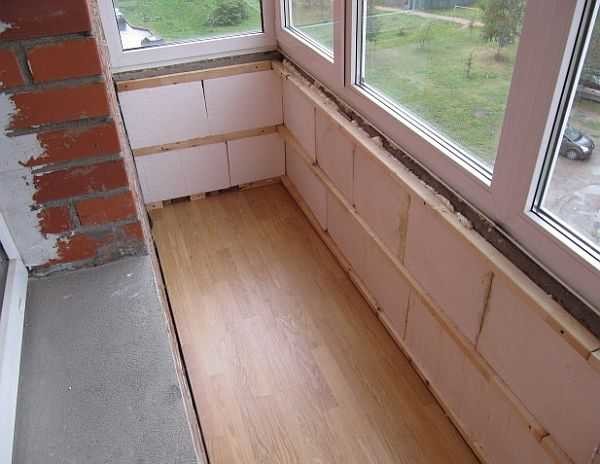
You can insulate the balcony under the clapboard with foam
- Mineral wool. They are made from molten rock, slag or fiberglass. So this insulation is natural. But in production, phenol-formaldehyde resins are used as a binder, which is not encouraging. There are basalt quilted mats, in the production of which binders are not used - they can be used even in children's institutions. The positive qualities of mineral wool are good thermal insulation properties, ease of use (but not with fiberglass). The disadvantage of this material is hygroscopicity, which is why it should be closed on all sides from moisture. The price range is medium.
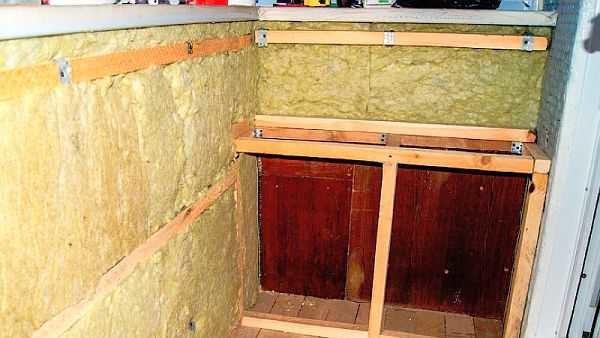
Mineral wool has good characteristics, but is afraid of moisture
- Extruded (extruded) expanded polystyrene (EPS). It has very good thermal insulation characteristics and high density, well resists mechanical stress. Along with thermal insulation, it dampens sounds well. Of the relatively inexpensive insulation materials, it is the most effective. Sold in slabs, has a system of locks, which eliminates the formation of gaps between which cold air penetrates. It is this material that is most often advised. If you have the material opportunity, put it under the clapboard trim. Among the disadvantages - it does not conduct steam and is not cheap.
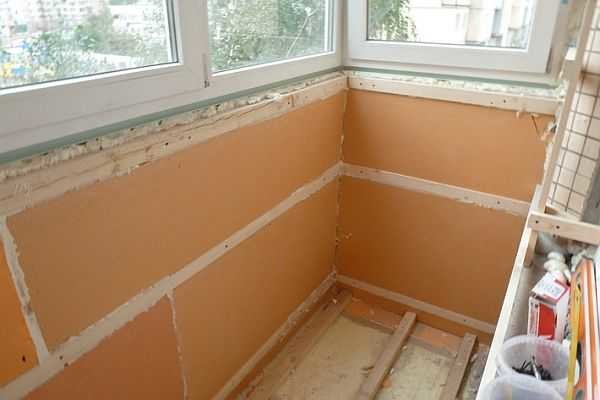
Extruded polystyrene foam is characterized by high density and low thermal conductivity
- Foiled polyethylene foam. This is an effective vapor barrier that prevents moisture from penetrating into the insulation. When using mineral wool, it must be rolled out from above, nailed with staples to the crate, the joints must be glued with foil tape. You can use just building foil, but it is more difficult to work with it, and the polyethylene layer is an additional heat insulator. This material alone can be used only in the southern regions, in the rest of the territory it is only an addition that improves thermal insulation.
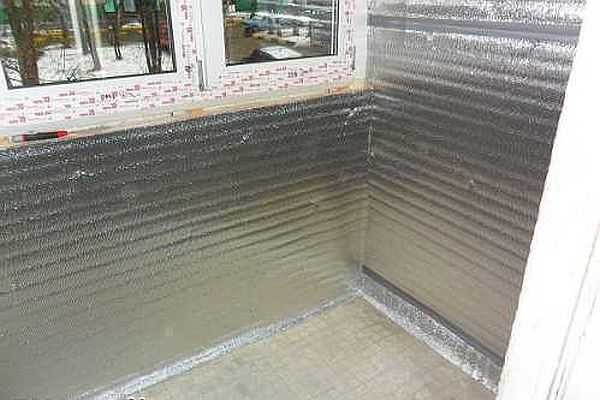
Foil-clad polyethylene is nailed on top of the insulation to reduce heat loss and prevent steam from entering the insulation
- For those who want to have environmentally friendly housing, there is a natural insulation with excellent characteristics: foamed glass (foam glass). It does not burn, does not emit anything, lightweight, durable, frost-resistant (operating temperature range from -260 ° C to + 230 ° C). Thermal conductivity of foam glass - 0.04-0.08 W / (m · K). Cut with a hacksaw, mounted on foam. The disadvantage is the high price. There is foam glass from Chinese manufacturers at reasonable cents, but the quality is below average, there is Belarusian - average in terms of price and characteristics, the best is European, but it is expensive.
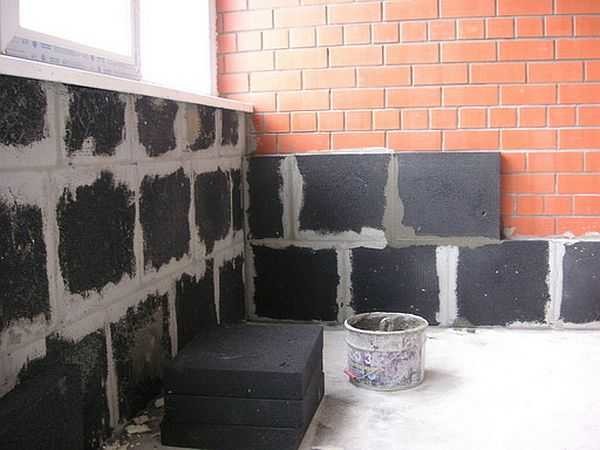
Foam glass is a natural heat-insulating material with very good characteristics
- Often foam blocks are used to insulate balconies. For normal efficiency, their thickness should be about 27 cm. Nobody will take such an area from a small room, so a layer of some of the thermal insulation materials described above is still put on top of the foam concrete.
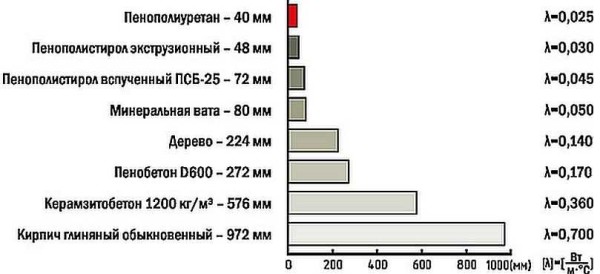
Comparison of thermal conductivity of various thermal insulation materials. The required material thickness is indicated in centimeters to ensure equal heat loss
Any of these insulation materials can be used on ceilings, floors, or walls. For the floor there is a natural and inexpensive option - expanded clay, but it is far from being as effective as the materials presented above: the average thermal conductivity is 0.1 W / (m K) (twice as high as that of mineral wool).
How to properly sheathe a balcony with clapboard
The balcony cladding is technologically not much different from the finishing of other rooms: first, the frame is assembled, then the cladding board is nailed to it. It is necessary to align the crate horizontally and vertically, and then correctly set the first bar on the wall or ceiling, since the installation of all the others is carried out from it. Then the second is nailed to the first board, then the third, and so on, to the corner. On the next wall, everything is repeated again.
We make the crate
Clapboard cladding begins with the creation of a frame - lathing. It is most often made from a bar. The section is selected depending on the thickness of the insulation (if any). The block should be of such a size that a gap of 1.5-2 cm remains above the surface of the insulation. This gap will allow maintaining the normal moisture content of the insulation and wood, which will prevent the appearance of fungi and mold.
If the timber of the required size turns out to be too expensive, you can save money. A block of the same thickness as the insulation (or slightly more) is taken under the crate. It is mounted between the guides, and a counter-lattice is stuffed on top, perpendicularly. It is made of strips 1.5-2 cm thick. They will give the required clearance. Only in this case you need not get confused with the direction of fastening the lining.
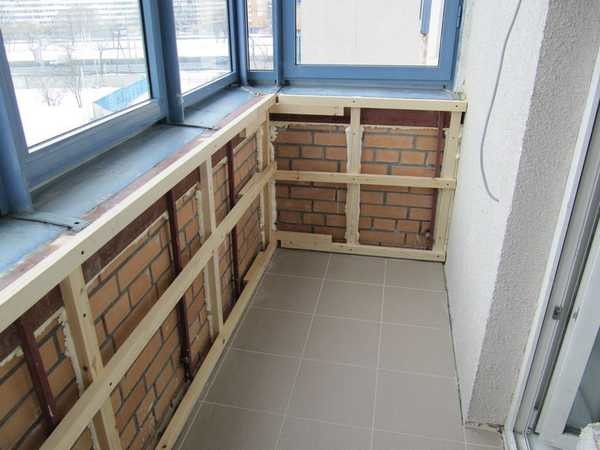
An example of a balcony lathing for a lining
Clapboard sheathing can be vertical or horizontal. The slats of the lathing under it are installed perpendicularly. If the trim will be mounted vertically, then the lathing under it should be horizontal.
In the presence of a counter-lattice, the rules change: the primary lathing is also packed (vertically), and the counter-lattice - horizontally. With this system, the planks will be mounted vertically.
More often clapboard cladding on the balcony is done vertically. Accordingly, the installation of the battens can be started from the strip under the window block. It is set horizontally, checking the level in two planes. If the wall is uneven, wood or plywood linings of the required thickness are installed in the right places. Fasten the crate with dowels.
The planks must be filled along the perimeter of the walls and ceiling, departing from the corners of 30-40 mm. Also, be sure to stuff around the perimeter of window and door openings. Then the intermediate bars are fixed: one bar from the other should be at a distance of 40-50 cm.It turns out a frame on the walls and ceiling, to which the lining is then attached.
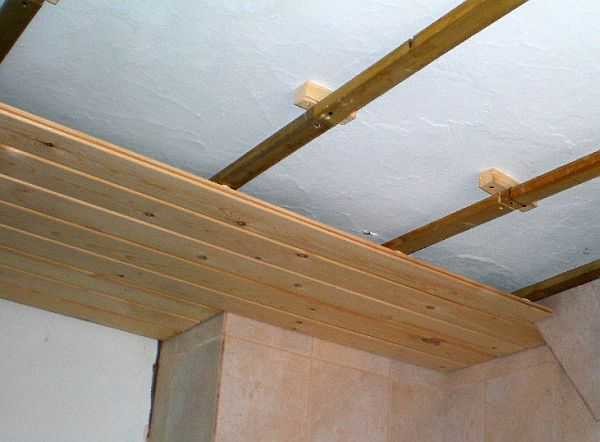
A similar structure is assembled on the ceiling
Lining boards are cut slightly shorter than the required length (0.5-1 cm). This is necessary to compensate for dimensional changes at high temperature and / or humidity.
Lining installation instructions
Fasten them with self-tapping screws or nails to the lathing strips. If you will use nails, take with a small head - finishing, self-tapping screws - for wood (better - light, not black). There is another option for fasteners - with staples from a construction stapler. This is the fastest and most reliable method. Only take staples with a long sharpened leg, T-shaped ones are also suitable.
The first plank is set in the most difficult corner to work with. It is put with a spike in a corner, the correct installation is checked with a building level. Nailed into the face (in the front surface), stepping back from the edge 1-2 cm. To prevent the wood from splitting, a hole is pre-drilled with a thin drill. Then they screw in a self-tapping screw or hammer in a nail.
On the opposite side (there is a groove there), the lining is fastened with nails, screws, staples. They are driven into a thorn at an angle of 45 °. It turns out a hidden mount - it is closed by the next board.
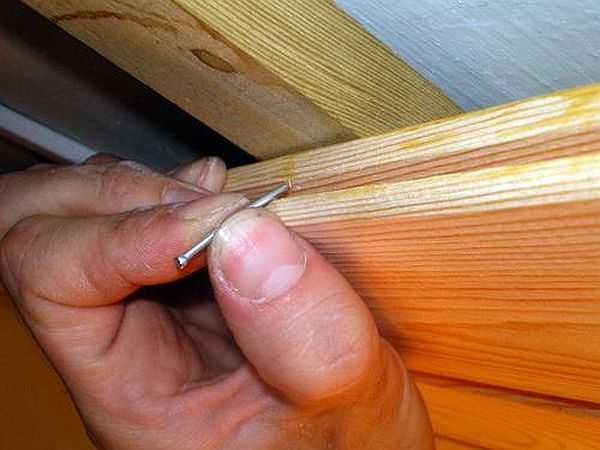
Fastening the lining with a nail (self-tapping screw, staple) into the groove
There is another option - clapboard cladding using special mounting plates - kleimers. They hold well if the spike is long enough, and this can most often be observed in the Euro lining. Kleimers are installed in a thorn (as if put on it). On the other hand, they have a mounting plate with nail holes. One or two carnations with a small cap are driven into this plate.

Fastening with cleats
The first board is attached to each batten of the crate, all subsequent ones - through one in a checkerboard pattern (alternating). The second board is inserted into the tenon of the first. If it does not fit tightly, it is knocked out with a small piece of wood against the plank. and a hammer. They hit a piece of wood with a hammer. This complexity is necessary to avoid damaging the board. Having driven the spike into the groove, they check whether the bar has become vertical. If necessary, correct, then nailed. This is how the whole clapboard is assembled. The last plank sometimes needs to be cut to width. It is fixed closer to the corner, like the first, in the face.
The process of installing the lathing and wooden lining is shown in the video.
The complete process of cladding a balcony - from the installation of external finishing to the installation of slopes and platbands, see the video below. We only worked with PVC panels, but the finishing steps are similar. The only difference is that the wooden lining has no starting strips. All the tops and bottoms are covered with plinths, and the corners - with corners.
How to process the lining
When sheathing a balcony with clapboard, it is necessary to treat with antiseptics not only finishing, but also all the lathing strips. The most popular protective impregnations and primers are listed below. Some of them can immediately give the wood a shade, without painting over, but emphasizing the texture.
- Senezh Aquadecor is a tinting antiseptic. If you cover the wood with this composition, it immediately protects against mold, fungi, insects, while giving one of 16 shades. Does not need a topcoat.
- Aquatex "Antiseptic Ground" - high-quality protection of the lining for subsequent topcoats (for example, under varnish).
- TIKKURILA VALTTI-POHJUSTE (TIKKURILA VALTTI-POHJUSTE) primer antiseptic for wood, protects against bio-damage, but does not protect against ultraviolet radiation. Therefore, the fastest staining is recommended.
- Impregnation Manor "U-409". Creates a thin polymer film on wood, through which steam penetrates, but this film prevents dirt from entering the wood, preserving the appearance of the finish. It contains additives that protect against fungi, mold and insects.
The packaging of each product has instructions for use and application.It describes application and application rules to ensure protection. Only if these rules are observed, you can be sure that the lining and the frame under it will serve for a long time.
If we talk about stains, then most of the modern compositions simultaneously with a change in the color of the wood also have protective properties. For example, Aquatex stain (analogue of Senezh Aquadecor). It has a wide range of colors, contains a difficult-to-wash antiseptic that protects wood from damage by fungi or insects.
The processing of the lining on the balcony can be done in different ways. It is most convenient to use tinting antiseptics for finishing the balcony. A one-time treatment will immediately protect and give color. But they only add color, leaving the pores open. Dirt can build up in these pores. And washing it out of there is not an easy task. If you also need a protective film that will prevent the penetration of dirt, you can cover the lining (tinted or not) with varnish or dirt-repellent impregnation of the U-409 Manor type. The impregnation creates a polymer film on the surface that closes the pores, but does not give shine.
Problems often arise on the sunny side: how to cover the lining on the balcony so that it does not fade. Light toning is best, which whitens the wood a little. A light wall heats up less and is not afraid of fading. Such clapboard cladding looks great.
If you want a shiny surface, you can use any varnish for interior work. For the types and types of varnishes, see the video. It will be easier for you to understand how to varnish the lining on the balcony.
Painting the lining on the balcony with ordinary paint is no longer relevant today. Why spend money on wood and then paint over its texture? Then you can put PVC right away. So choose: tinting, varnishing, or both.

